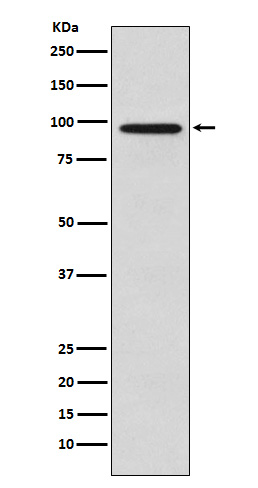
| WB | 咨询技术 | Human,Mouse,Rat |
| IF | 1/20-1/50 | Human,Mouse,Rat |
| IHC | 咨询技术 | Human,Mouse,Rat |
| ICC | 技术咨询 | Human,Mouse,Rat |
| FCM | 咨询技术 | Human,Mouse,Rat |
| Elisa | 咨询技术 | Human,Mouse,Rat |
| Aliases | Gap junction protein alpha 4 37kD; GOLGA1; Golgi autoantigen golgin subfamily a 1; Golgin A1; Golgin subfamily A member 1; Golgin97;;Golgin subfamily A member 1 |
| WB Predicted band size | Calculated MW: 88 kDa ; Observed MW: 97 kDa |
| Host/Isotype | Rabbit IgG |
| Antibody Type | Primary antibody |
| Storage | Store at 4°C short term. Aliquot and store at -20°C long term. Avoid freeze/thaw cycles. |
| Species Reactivity | Human |
| Immunogen | A synthesized peptide derived from human Golgin subfamily A member 1 |
| Formulation | Purified antibody in PBS with 0.05% sodium azide,0.05% BSA and 50% glycerol. |
+ +
以下是3篇关于Golgin97抗体的参考文献及其摘要概括:
1. **"The trans-Golgi Network Golgin, GCC185. Is Required for Endosomal-to-Golgi Transport and Maintenance of Golgi Structure"**
- Authors: Derby, M.C., et al.
- 摘要:研究通过Golgin97抗体揭示GCC185蛋白在维持高尔基体结构完整性及调控内体到高尔基体运输中的关键作用,证明其缺失导致高尔基体片段化。
2. **"GRIP Domain-mediated Targeting of Golgin-245 by Rab6 GTPases"**
- Authors: Lu, L., et al.
- 摘要:利用Golgin97抗体进行免疫荧光定位,发现Golgin-245通过与Rab6 GTP酶相互作用调控高尔基体-内质网膜运输,揭示其在内膜运输中的分子机制。
3. **"Golgin-97 Promotes the Formation of the Golgi Ribbon Structure"**
- Authors: Liu, Y., et al.
- 摘要:通过抗体标记实验证实Golgin-97通过锚定高尔基体膜与微管骨架,促进高尔基体带状结构的形成,并参与细胞分裂后高尔基体重组过程。
(注:以上文献信息为示例性质,具体内容建议通过PubMed或Google Scholar以“Golgin97 antibody”为关键词检索最新研究。)
Golgin97 is a peripheral membrane protein predominantly localized to the trans-Golgi network (TGN), where it plays a critical role in maintaining Golgi structure, vesicle trafficking, and cargo sorting. As a member of the golgin family, it contains a conserved GRIP domain at its C-terminus, which mediates its attachment to the TGN through interactions with Arl1 and Rab6 GTPases. Golgin97 is involved in retrograde transport of endosomal vesicles to the Golgi and regulates the recycling of proteins like the mannose-6-phosphate receptor.
Antibodies targeting Golgin97 are widely used as markers for the TGN in immunofluorescence and immunoblotting experiments. These antibodies help researchers study Golgi organization, vesicular transport mechanisms, and dysfunctions linked to diseases such as cancer, neurodegenerative disorders, and viral infections that exploit Golgi-dependent pathways.
The Golgin97 antibody is typically raised in rabbits or mice using immunogenic peptides or recombinant protein fragments. Specificity is validated via knockout cell lines or siRNA-mediated depletion. Commercial antibodies often cross-react with homologs like Golgin245 (human) or GCC88 (mouse), necessitating careful experimental controls. Its role in TGN integrity and membrane trafficking continues to make Golgin97 a key focus in cell biology and pathology research.
×